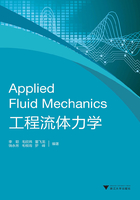
Preface
The motivation to write a book is because the bilingual course about fluid mechanics need to have a simplified English book matching with 40 class hours.This is the fluid book covering in a typical one-semester undergraduate fluid mechanics course.This book was written based on the Applied Fluid Mechanics(Chinese version)by Mao Genhai; Shao Weiyun; and Zhang Yan.This is not an easy task:Fluid mechanics is a subj ect that contains many difficult-to-understand concepts.For example, what is streamline, pathline and streakline? Or what is lone pipe and short pipe? Or what is subcritical flow, critical flow and supercritical flow? A number of changes comparing Applied Fluid Mechanics(Chinese version)have been made to simply clarify or expand certain ideas or concepts.In addition, we have attempted to present fluid mechanics so that the students can understand and analyze many of the important concepts and phenomena encountered by the engineer.
One of our aims remains to represent fluid mechanics as it really is an exciting and useful discipline.In the text, we include analyses of numerous examples of fluid phenomena to which students and faculty can easily relate.In the first two chapters, the students are made aware of some fundamental aspects of fluid mechanics and fluid statics, including characteristics of fluids, forces on fluid, basic equations for pressure field, hydrostatic force on a plane surface and a curved surface etc.The Bernoulli equation is introduced in Chapter 3 to draw attention, early on, to some of the interesting effects of fluid motion on the distribution of pressure in a flow field.Chapter 4,5, and 6 expand on the basic analysis methods generally used to solve or to begin solving fluid mechanics problems.Emphasis is placed on how to use infinitesimal and finite control volumes.The advantages of using dimensional analysis and similitude for organizing test data and for planning experiments and the basic techniques involved are featured in Chapter 5.
Chapter 7,8, and 9 include practical concerns such as orifice flow, nozzle flow, pipe flow and open channel flow.Chapter 10,11, and 12 include weir flow and seepage flow.A major new feature of this book is addition of chapter 12 compressible gas flow. This new chapter, explain the compressible gas flow phenomena to make students and faculty in civil engineering easily understand.
New features in the book include:information about computational fluid dynamics, with supporting figures and photograph; and the characteristics and properties of the ·1 ·main types of equations used in fluid mechanics.
We express our thanks to many students and colleagues who have helped in the achievement of this text, special thanks to Duan Haojie, Chen Xinbo, Zhang Tuqiao, He Guilin, Zhang Yiping, Yang Yulong, Zhang Yan.In addition, we are very grateful for the care, assistance, and guidance that Wang Bo at Zhejiang University Press and education project at college of civil engineering and architecture in Zhejiang University in preparing this book.We hope that this new, concise and English introduction to fluid mechanics will be appealing to students, especially for Chinese students and will make the material more readily accessible to them.Our goal has been to develop a unique, user-friendly, introductory text that clearly focuses on the essential aspects of the subj ect.Further comments and suggestions from users, are always welcome.
Li Cong